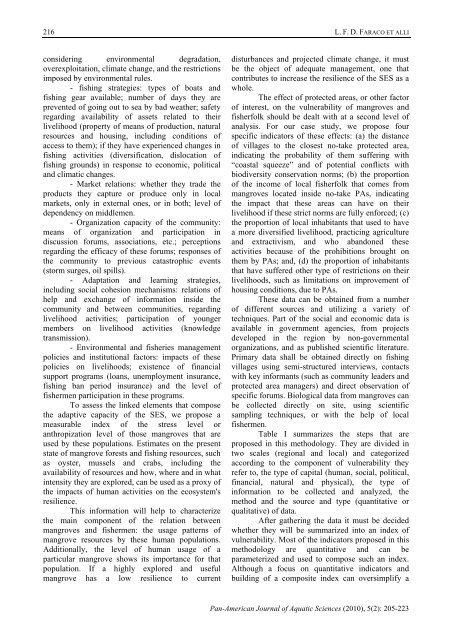Download full issue - PanamJAS
Download full issue - PanamJAS
Download full issue - PanamJAS
- No tags were found...
Create successful ePaper yourself
Turn your PDF publications into a flip-book with our unique Google optimized e-Paper software.
216L. F. D. FARACO ET ALLIconsidering environmental degradation,overexploitation, climate change, and the restrictionsimposed by environmental rules.- fishing strategies: types of boats andfishing gear available; number of days they areprevented of going out to sea by bad weather; safetyregarding availability of assets related to theirlivelihood (property of means of production, naturalresources and housing, including conditions ofaccess to them); if they have experienced changes infishing activities (diversification, dislocation offishing grounds) in response to economic, politicaland climatic changes.- Market relations: whether they trade theproducts they capture or produce only in localmarkets, only in external ones, or in both; level ofdependency on middlemen.- Organization capacity of the community:means of organization and participation indiscussion forums, associations, etc.; perceptionsregarding the efficacy of these forums; responses ofthe community to previous catastrophic events(storm surges, oil spills).- Adaptation and learning strategies,including social cohesion mechanisms: relations ofhelp and exchange of information inside thecommunity and between communities, regardinglivelihood activities; participation of youngermembers on livelihood activities (knowledgetransmission).- Environmental and fisheries managementpolicies and institutional factors: impacts of thesepolicies on livelihoods; existence of financialsupport programs (loans, unemployment insurance,fishing ban period insurance) and the level offishermen participation in these programs.To assess the linked elements that composethe adaptive capacity of the SES, we propose ameasurable index of the stress level oranthropization level of those mangroves that areused by these populations. Estimates on the presentstate of mangrove forests and fishing resources, suchas oyster, mussels and crabs, including theavailability of resources and how, where and in whatintensity they are explored, can be used as a proxy ofthe impacts of human activities on the ecosystem'sresilience.This information will help to characterizethe main component of the relation betweenmangroves and fishermen: the usage patterns ofmangrove resources by these human populations.Additionally, the level of human usage of aparticular mangrove shows its importance for thatpopulation. If a highly explored and usefulmangrove has a low resilience to currentdisturbances and projected climate change, it mustbe the object of adequate management, one thatcontributes to increase the resilience of the SES as awhole.The effect of protected areas, or other factorof interest, on the vulnerability of mangroves andfisherfolk should be dealt with at a second level ofanalysis. For our case study, we propose fourspecific indicators of these effects: (a) the distanceof villages to the closest no-take protected area,indicating the probability of them suffering with“coastal squeeze” and of potential conflicts withbiodiversity conservation norms; (b) the proportionof the income of local fisherfolk that comes frommangroves located inside no-take PAs, indicatingthe impact that these areas can have on theirlivelihood if these strict norms are <strong>full</strong>y enforced; (c)the proportion of local inhabitants that used to havea more diversified livelihood, practicing agricultureand extractivism, and who abandoned theseactivities because of the prohibitions brought onthem by PAs; and, (d) the proportion of inhabitantsthat have suffered other type of restrictions on theirlivelihoods, such as limitations on improvement ofhousing conditions, due to PAs.These data can be obtained from a numberof different sources and utilizing a variety oftechniques. Part of the social and economic data isavailable in government agencies, from projectsdeveloped in the region by non-governmentalorganizations, and as published scientific literature.Primary data shall be obtained directly on fishingvillages using semi-structured interviews, contactswith key informants (such as community leaders andprotected area managers) and direct observation ofspecific forums. Biological data from mangroves canbe collected directly on site, using scientificsampling techniques, or with the help of localfishermen.Table I summarizes the steps that areproposed in this methodology. They are divided intwo scales (regional and local) and categorizedaccording to the component of vulnerability theyrefer to, the type of capital (human, social, political,financial, natural and physical), the type ofinformation to be collected and analyzed, themethod and the source and type (quantitative orqualitative) of data.After gathering the data it must be decidedwhether they will be summarized into an index ofvulnerability. Most of the indicators proposed in thismethodology are quantitative and can beparameterized and used to compose such an index.Although a focus on quantitative indicators andbuilding of a composite index can oversimplify aPan-American Journal of Aquatic Sciences (2010), 5(2): 205-223
















